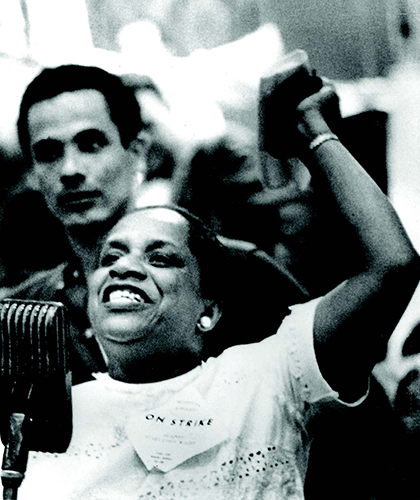Women In The Vanguard
April 23, 2020

After 1199 secured its first hospital contract at Montefiore Hospital in the Bronx, the leadership brought Monte African-American LPN Thelma Bowles onto its initial hospital organizing team.
Others soon distinguished themselves. Gloria Arana, who hailed from Puerto Rico and worked in the laundry worker at Mt. Sinai Hospital in Manhattan, had never been in a strike before the 1959 action. Soon though, her word became gospel at the Mt. Sinai laundry, and she helped lead the walkout during the decisive 1959 strike.
Another highly respected leader of the hospital organizing campaign was Hilda Joquin, a dietary worker at Manhattan’s Beth Israel Medical Center. A native of Bermuda, Joquin’s firing rallied members to her defense and reinstatement. Later, a supervisor warned Joquin that she would be fired if she continued to wear a Union button on her uniform. Staring the supervisor directly in the eye, Joquin took the button off her lapel and pinned it in her hair. And Doris Turner, 1199’s second president, started as a dietary clerk at Lenox Hill Hospital.
The Union sisters are just a few examples of the thousands of 1199 women who over the years have come to the fore at their workplaces, communities and in political and legislative circles. Organizing campaigns produced leaders such as Mary Moultrie in South Carolina and Mattie Best in Rochester. 1199 sisters have held political office on the local and state levels. Others have gone on to lead other unions and organizations. For example, Jill Furillo, the recently retired executive director of the New York State Nurses Association, came out of the ranks to head 1199’s RN division.

1199 also led the way with contracts gains that were especially helpful to working women, such as the creation of expansive training programs and the only Child Care Fund in the U.S. labor movement.
In the late 1980s, the Union mounted a campaign that galvanized support for some of the most poorly paid employees in the country—home care workers. The campaign eventually won a contract that called for a 42 percent raise over three years. The Union also formed a new division and today, 1199’s Home Care Division represents some 125,000 workers— overwhelmingly women—throughout the Union.
In keeping with 1199’s history, many of these members (as well as those in other divisions) have emerged as leaders in the campaigns for immigrant rights and for a $15-an-hour minimum wage.
Over the years, 1199’s Bread and Roses Cultural Program (B & R), has played a leading role in the fight for equal rights. In 1979, a play with music, “I Just Wanted Someone to Know,” about the lives of working women, toured hospitals in three states for six weeks. And in the 1990s, B & R produced five series of “Women of Hope” posters, with accompanying biographical sketches and study guides. The powerful images were exhibited around the world in union halls, schools, public venues, and at the United Nations.
In recent years, 1199 regions have hosted an array of International Women’s Month programs. The Union’s New Jersey Division partners with labor, political and community leaders to commemorate International Women’s Day on March 8. And 1199’s Women’s Caucus marks the day each year with a colorful parade of costumes worn by members and staff that highlights the Union’s great diversity.
Mattie Best, the leader of Rochester’s Strong Memorial campaign, said that after she retired, she would return to Strong, stand outside and say to herself, “This is something that I helped build.” Today women lead the steadfast building of the nation’s largest and most influential healthcare union.
1199 Magazine | March / April 2020

